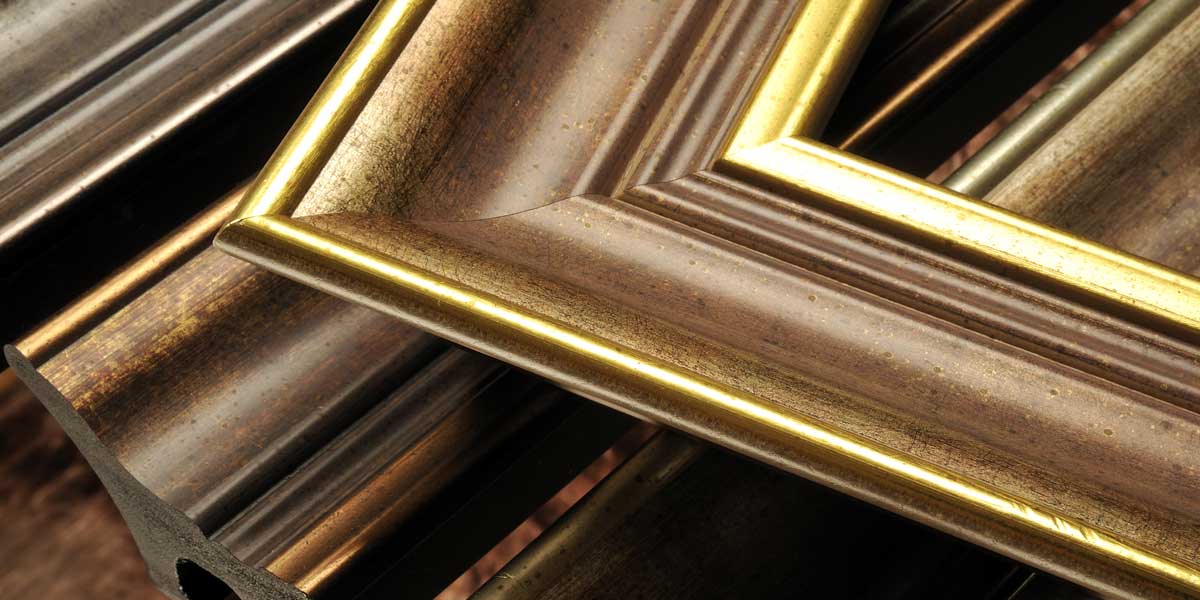Picture frame moulding is the actual material that is used to make a picture frame. Custom framers and companies like FinerWorks order this in lengths of anywhere from 8 to 12 ft as produced by the manufacturer. At FinerWorks, we use several of the largest moulding supply companies which traditionally have been the suppliers for the local corner frame shop. These lengths of mouldings are cut into 4 sections (two for the width and two for the height) using specialized angled saws to ensure the corners are accurate and precise.
Corners are joined sometimes with a combination of glue and v-nails providing a strong corner that is needed to hold both the weight of the artwork and sometimes glazing (acrylic or glass) panes.
One of the things I sometimes tell people is frame mouldings come in various levels of quality and the quality is proportional to the price. Picture frame mouldings can be budget-friendly or very expensive by length, depending on the size, thickness, materials used, and where it is manufactured.
I like to break them down into about 3 different categories. Polystyrene (sometimes referred to as just “poly”, MDF, and solid wood).
Polystyrene
Polystyrene frames are made of extruded hard plastic which can usually put them in a more budget-friendly category. Aside from them coming in various styles, they can mimic the appearance of higher-end frames made of wood or metal, making them very aesthetically appealing. Not until you touch and feel one do you realize it is something else.
The advantage of these frames is they are lightweight, sturdy, and generally more affordable picture frames. What has driven their popularity is there are a lot of different styles and colors to choose from. I have heard of some framers looking down upon them or even not offering poly frames. A few suppliers may not even carry them but that may be changing as well as their popularity is evident in the growing market.
However poly frames do have some disadvantages. One is some customers may find the feel of “plastic” off-putting. The lengths of polystyrene can also twist and warp just slightly enough that it can sometimes affect the quality of the corners. Overall, many of our customers have been very receptive to these since they improve their margins when trying to sell their art in a frame.
MDF
MDF frames are probably the most common type of frame today used by custom frame shops and found at your local art supply store. MDF stands for Medium-Density Fiberboard. It’s an engineered wood product made from wood fibers, combined with resin and wax, and formed into panels under high temperature and pressure. MDF is commonly used in furniture manufacturing, cabinetry, shelving, and of course material for picture frames.
A veneer is often applied to MDF frames to enhance their appearance and give them certain stylish looks. Veneers are thin layers of decorative material, such as wood, laminate, or even fabric, that are bonded to the surface of the MDF frame. This allows manufacturers to achieve the look of more expensive materials, such as solid wood or exotic woods, at a fraction of the cost.
Veneers can come in a variety of finishes and styles, including wood grain, high-gloss, matte, or textured finishes. They can also be stained or painted to match specific color schemes or design preferences. By applying veneers to MDF frames, manufacturers can create frames that mimic the appearance of premium materials while retaining the affordability and stability of MDF. This makes veneered MDF frames a popular choice for those seeking stylish and cost-effective framing options.
There are not a lot of disadvantages which is another reason why they are popular but the biggest complaints are that they are more susceptible to moisture, heavier and softer than most solid wood frames, making corner integrity not as strong as a poly frame or solid wood.
Solid Wood Frames
Solid wood frames are picture frames made entirely from natural wood, as opposed to engineered wood products like MDF. These frames are crafted from solid pieces of lumber, offering durability, beauty, and a timeless appeal. Solid wood frames can be stained, painted, or left unfinished to showcase the natural grain of the wood.
Several types of wood are commonly used to make solid wood frames, each with its own characteristics: These include Oak, Maple, Cherry, Walnut, Mahogany, and Pine.
Depending on the desired aesthetic, budget, and availability, other woods such as ash, birch, or poplar may also be used. Each type of wood offers unique characteristics and can contribute to the overall look and feel of the framed artwork.
Using veneers with solid wood frames allows for greater customization and versatility in design. For example, a solid wood frame made from a less expensive wood species like pine may be veneered with a more desirable wood veneer, such as cherry or walnut, to create the appearance of a higher-quality frame. Additionally, veneers can be used to cover imperfections in the wood or to add decorative elements like inlay or marquetry.
The biggest disadvantage to solid wood frames is they are less budget-friendly since the material cost is so much higher. But if budget is not as much of a concern, the solid wood frames offer durability and authenticity, and the addition of veneers allows for a wider range of design possibilities and can help achieve specific aesthetic goals.
Order HD Chromaluxe® Metal Prints
Print your artwork or photography as custom-size metal prints. Using the dye-sublimation process, your image is fused to the surface of rigid aluminum panels. These provide a modern look when decorating your home or office. Choose from multiple metal surface options. Order it framed, with a float wall mounting or even with a tabletop easel back.

